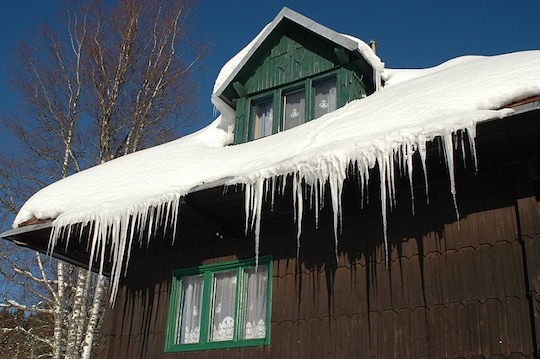
Everyone has been spending more time at home recently, and it shows — between 2020 and 2021, the number of home remodeling projects increased by 38%.
Mientras los propietarios siguen invirtiendo en mejoras para sus propiedades, aquí te mostramos algunas de las principales ideas de mejoras para el hogar que puedes probar en 2021.
1. Give Your Home's Exterior a Face-lift
In 2020, homeowners who made improvements to the outside of their property made back anywhere between 50% and 95% of their investment. Just repainting your siding or adding a stone veneer can transform the look of your home; you may also consider swapping out your front and garage doors for newer ones.
Replacing your roof is another improvement that can add aesthetic appeal while bringing financial returns. A recent remodeling impact report from the National Association of the Remodeling Industry estimates that a new roof pays back as much as 107% of its cost upon the resale of a house.
Architectural shingles, which help protect your home against wear and tear from weather conditions, come in many styles and colors to match any decor. Choosing roof shingles in the right color can quickly boost your home's curb appeal. If you need help determining which color or style of shingles will look best on your home, upload a photo of your house to GAF's Virtual Remodeler tool to visualize your options.
2. Improve Your Interior's Air Quality
And speaking of the exterior of your home: depending on where you live, the air indoors could be between two to five times more polluted than the air outdoors, according to the US Environmental Protection Agency. Improving the indoor air quality is important for the overall health and well-being of everyone who lives there.
Common indoor pollutants include asbestos, radon, mold, carbon monoxide emissions from central heating systems or gas stoves, household chemicals, and cigarette smoke. Change your filter annually or every six months if you live near a highway or in a wildfire zone.
Be mindful when choosing renovation materials, as they can affect your indoor air quality. Stick to paints and carpeting low in volatile organic compounds to prevent off-gassing; avoid products like strong-smelling glues, adhesives, and some particle board as they're able to release formaldehyde. The California Air Resources Board offers information about products that affect air quality both positively and negatively.
3. Close off Rooms
In many homes, open-concept spaces have been divided into quiet spaces for remote work and online learning. Rather than knocking down walls, homeowners are putting them up—and in the process they're maximizing underused space such as staircase nooks, large closets, and top-floor landings to create private areas for work, study, and hobbies.
Not all room divisions have to be walls, though—adding sliding doors or standing partitions like room screens can visually break up large open areas, while soundproofing panels lend a hush to home offices.
4. Create a Spa-like Bathroom
Both mid-range and high-end kitchen and bathroom renovations are up about 20% since 2020. A recent design trends study found that more than 40% of homeowners have renovated their master bathroom specifically with rest and relaxation in mind—spa-like features such as radiant floor heating, oversized soaking tubs, steam showers, aromatherapy showerheads, and soothing colors all contribute to a stress-free zone. Elevate the space even further by including barrier-free showers with linear drains and toilets with self-closing lids.
5. Expand Entertainment and Workout Areas
Basement remodeling projects are a great way to create a recreational space for the entire family to play games or watch movies.
Some home design trends for basements in 2021 include recreational add-ons like home cinemas, arcades, climbing walls, miniature bowling lanes, and golf simulators. Home gyms are another hugely popular upgrade as more people become accustomed to working out at home—consumer sales of fitness equipment increased by 170% in 2020.
6. Convert Storage Sheds to Additional Living Space
Homeowners who don't want to invest in a full home addition can convert an existing accessory dwelling unit, sturdy shed, or upcycled shipping container into a home office, yoga studio, playroom, or even guest suite. Zoning regulations vary from state to state, but many areas allow outbuildings in the backyard.
7. Plan the Ultimate Backyard Oasis
Setting up a comfortable and stylish outdoor living space allows homeowners to make the most of patio season and make a valuable home investment. Sliding or folding glass doors can open up the space, letting in more natural light and creating a natural flow from the indoors. Incorporating similar color palettes and furniture styles both inside and out makes for a seamless transition between the spaces.
Consider adding a new deck or stone patio, putting up a pergola for privacy, and investing in plush outdoor sectional sofas with soft rugs underfoot. Other popular features include in-ground pools, outdoor kitchens with integrated barbecues and pizza ovens, and fire features such as fire tables, fire pits, or fire columns. Good lighting can transform a space-experiment with string lights, solar sconces, or hurricane lanterns to help warm up chilly fall evenings. Standing outdoor heaters will extend the outdoor activities further into the year.
8. Reconfigure the Kitchen
When there are too many cooks in the kitchen, it's time to make more room. That's probably why multizone kitchens are another huge trend in home improvement-so that families preparing meals together can work at oversized kitchen island hubs, peninsulas or built-in seating areas. Adding more storage solutions such as pull-out drawers and open shelving can also upgrade your kitchen to be more beautiful and practical at the same time.
Now is the perfect time to upgrade your space, inside and out, with home improvement ideas designed to make the most of your space and style. Many contractors can provide a variety of home improvement and home repair services, including roofing. If you're considering a roof replacement, you can find a contractor certified by GAF* by using this contractor locator.
*Los contratistas inscritos en los programas de certificación de GAF no son empleados ni agentes de GAF, y GAF no controla ni supervisa de otro modo estas empresas independientes. Los contratistas pueden recibir beneficios, como puntos y descuentos de recompensa por lealtad en herramientas de comercialización de GAF por participar en el programa y ofrecer a GAF garantías mejoradas, que requieren el uso de una cantidad mínima de productos de GAF.



